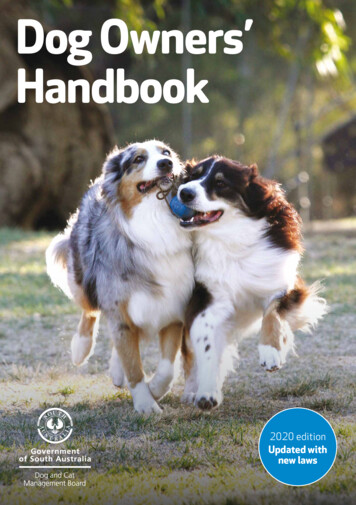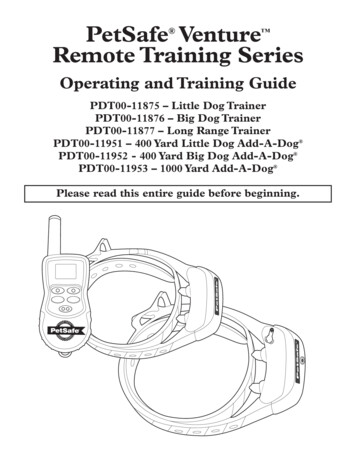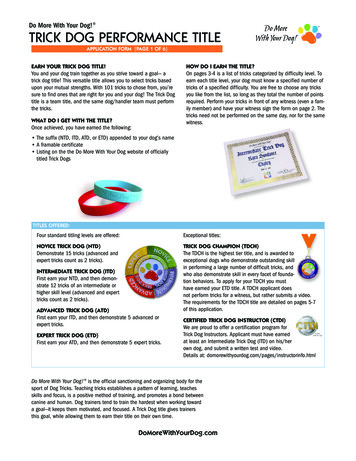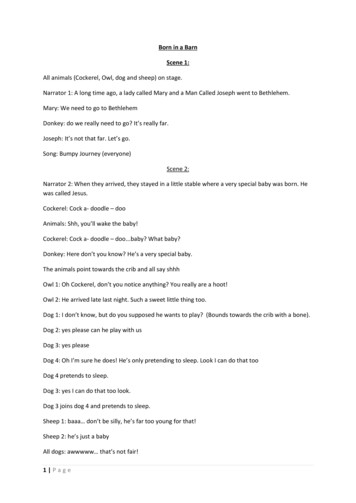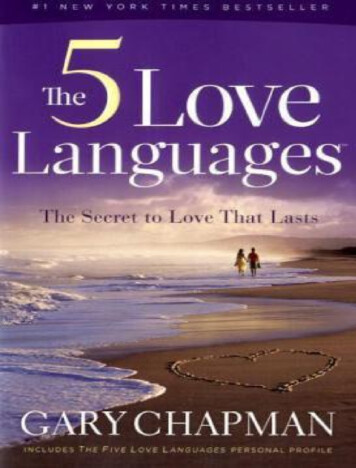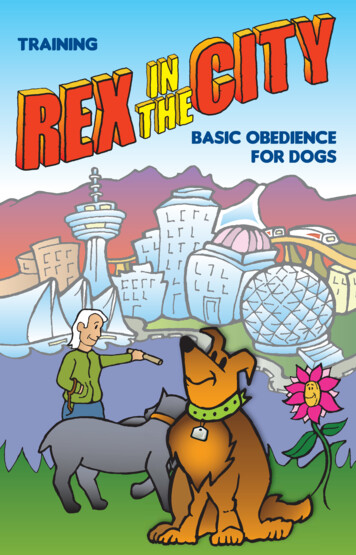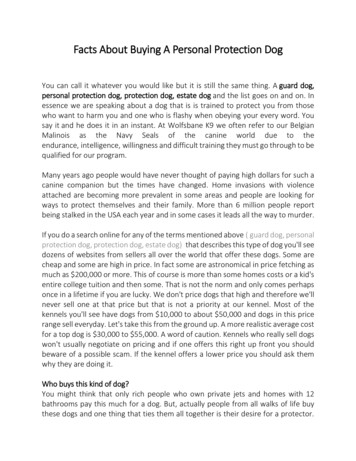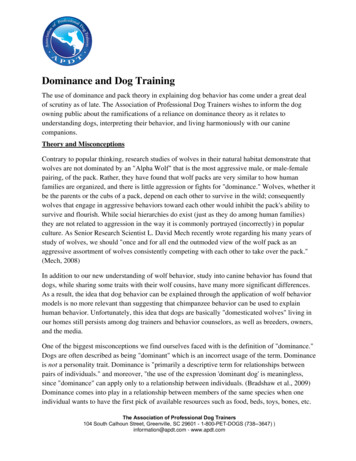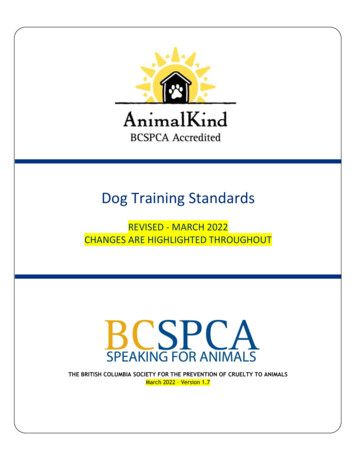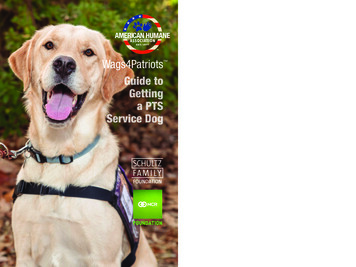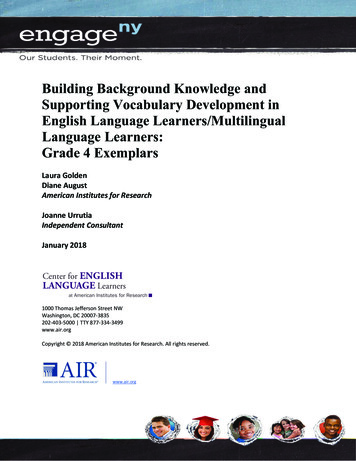
Transcription
Building Background Knowledge andSupporting Vocabulary Development inEnglish Language Learners/MultilingualLanguage Learners:Grade 4 ExemplarsLaura GoldenDiane AugustAmerican Institutes for ResearchJoanne UrrutiaIndependent ConsultantJanuary 20181000 Thomas Jefferson Street NWWashington, DC 20007-3835202-403-5000 TTY 877-334-3499www.air.orgCopyright 2018 American Institutes for Research. All rights reserved.www.air.org
ContentsGrade 4: Love That Dog.1Background: What Is a Poem? .2Glossary of Key Vocabulary: Love That Dog.7Grade 4: The Birth of the Haudenosaunee.11Background 1: Historical Texts.12Background 2: The People of the Longhouse .17Glossary of Key Vocabulary: The Birth of the Haudenosaunee .28 2018 American Institutes for ResearchBackground and Vocabulary Exemplars for ELLs Grade 4—i
Grade 4: Love That odule-1b-unit-2-lesson-6OverviewBackground 1:What Is a Poem?American Institutes for Research (AIR) developed this activityto provide students with background information on poetrybefore they read Love That Dog. The lesson defines poetryterms and provides examples of each term from the book.INSTRUCTIONS FOR TEACHERS Glossary of key vocabularyLove That DogTurn to Expeditionary Learning: Grade 4: Module 1B:Unit 1: Lesson 1.Follow the instructions for the Opening and WorkTime Parts A and B.Complete the background activity called “What Is aPoem?”which AIR has provided on the followingpages. Follow the instructions for Work Time Part C,Closing and Assessment, and Homework from theExpeditionary Learning materials.This glossary provides definitions and sample sentences forkey vocabulary drawn from Love That Dog (pages 1–31). Thequartile from the list of the 4,000 most frequent words is alsoprovided, where applicable. Glossed words include thoseidentified in the Expeditionary Learning materials and thoseidentified by AIR staff as key to understanding the text. 2018 American Institutes for ResearchBackground and Vocabulary Exemplars for ELLs Grade 4—1
Background: What Is a Poem?What Is a Poem?Love That Dog is the story of a boy who does not like the poetry assignments given by histeacher. The book is written as a free-verse, irregular poem. Before we read Love That Dog,we are going to learn about poems. You will see some examples of poems from the book andlearn vocabulary related to poetry.INSTRUCTIONS FOR STUDENTS Look at the guiding question. Read the text about poems. Use the glossary to help you understand new words. Answer the supplementary questions. Answer the guiding question. Discuss your answers with the class.Guiding Question: What is a poem?GlossaryA poem is a type of writing. Poems have aspecial form, style, and structure.imagine – to form a picture in your mindPoems use words and phrases to help usimagine things. Poems often expressemotions or feelings. Poems have beauty.repeat – to say or write words several timesSome poems have words that rhyme. Somepoems repeat phrases.style – the way something is writtenSome poems have stanzas and lines. Some poemsform a shape.Poetry TermsExamples From Love that DogStructure – how a poem is organized; what apoem looks like. Line – a row with a group of words Stanza – a group of lines divided by aspaceThe Red Wheelbarrow by William CarlosWilliams (page 91) 2018 American Institutes for ResearchBackground and Vocabulary Exemplars for ELLs Grade 4—2
Four stanzas/two lines per stanzaso much depends (line 1)upon (line 2)stanza 1a red wheel (line 1)barrow (line 2)stanza 2glazed with rain (line 1)water (line 2)stanza 3beside the white (line 1)chicken. (line 2)stanza 4Free verse – an irregular structure (astructure that is not normal); not broken intostanzas; has many linesDog by Valerie Worth (page 97)Concrete structure – words written in theshape of what the poem is aboutThe Apple by S. C. Rigg (page 103)Imagery – words and phrases used to helpthe reader imagine with the senses (sight,sound, touch, taste, smell)Words that help me SEE:Under a maple treeThe dog lies down,Lolls his limpTongue, yawns,Rest his long chinCarefully betweenFront paws;Looks up, alert;My Sky by “Jack” (page 68)“with his tail wag-wag-wagging and hismouth slob-slob-slobbering”Words that help me HEAR: 2018 American Institutes for ResearchBackground and Vocabulary Exemplars for ELLs Grade 4—3
Street Music by Arnold Adoff (page 100)“slamming from bus tires and taxi horns andengines of cars and trucks in all”Words that help me TASTE:The Apple by S. C. Rigg (page 103)“apple yum apple juicy, juicy, juicy crunchy, crunchy, crunchy ”Punctuation – marks in writing that separatesentences and parts of sentences to make themeaning clearDog by Valerie Worth (page 97) usescommas and semicolons to help the readerknow when to pause in the poem:Rhythm – emphasis on certain syllables orwords throughout a pieceLove That Boy by Walter Dean Myers (page105)Under a maple treeThe dog lies down,Lolls his limpTongue, yawns,Rest his long chinCarefully betweenFront paws;Looks up, alert;Love that boy,Like a rabbit loves to runI said I love that boyLike a rabbit loves to runLove to call him in the morningLove to call him“Hey there, son!”Rhyme – words that have the same endsoundsStopping by the Woods on a Snowy Eveningby Robert Frost (page 93)My little horse must think it is queerTo stop without a farmhouse nearBetween the woods and frozen lakeThe darkest evening of the year. 2018 American Institutes for ResearchBackground and Vocabulary Exemplars for ELLs Grade 4—4
The Pasture by Robert Frost (page 99)Repetition – using words and/or lines morethan onceI’m going out to clean the pasture spring;I’ll only stop to rake the leaves away(And wait to watch water clear, I may):I shan’t be gone long.—You come too.I’m going out to fetch the little calfThat’s standing by the mother. It’s soyoungIt totters when she licks it with her tongue.I shan’t be gone long.—You come too.Street Music by Arnold Adoff (page 100)Free verse – a poem written with no rhymeand no regular rhythmvocabularyofclashflashscreechinghot metal l a n g u a g ec o m b i n a t i o n s;My Sky by “Jack” (page 68)Narrative poem* 1 – a poem that tells a story1We were outsidein the streetme and some other kidskicking the ballbefore dinnerand Sky waschasing chasing chasingwith his feet goingevery which wayand his tailwag-wag-waggingand his mouthslob-slob-slobberinghe wasall over the placeWords with an asterisk (*) are highlighted in the Expeditionary Learning lessons. 2018 American Institutes for ResearchBackground and Vocabulary Exemplars for ELLs Grade 4—5
smiling and waggingand slobberingand makingus laughWord storySupplementary Questions1. What is the structure of a poem?The structure of a poem is how it is in lines and stanzas. [EN, EM]The structure of a poem is . [TR]2. What is a free-verse poem?A free-verse poem is a poem with no and no regular . [EN, EM]A free-verse poem . [TR]3. How do poems create rhythm?Poems create rhythm by placing on certain syllables or words throughouta piece. [EN, EM]Poems create rhythm by . [TR]4. What is the meaning of the word “rhyme”?Words rhyme when they have the same end . [EN, EM]Words rhyme when . [TR]5. How do poems use imagery?Poems use words to make us with our about how things look,sound, taste, feel, or smell. [EN, EM]Poems use imagery to . [TR]6. What is a narrative poem?A narrative poem is a poem that tells a . [EN, EM]A narrative poem is . [TR]Response to Guiding Question: What is a poem? 2018 American Institutes for ResearchBackground and Vocabulary Exemplars for ELLs Grade 4—6
Glossary of Key Vocabulary: Love That rotection(shelter)shelterrefugio deprotección paraanimalesanonymousN/AanónimoDefinitionon or touching somethinga place that provides a temporaryhome for animalsnot known; secret; no nameat leastal menosbesideal lado deQ1 (least)if nothing elseQ1next to; at the side ofboardtablónQ1a flat piece of woodbrickladrilloQ3block of claybrightbrillanteQ1giving a lot of lightbunchun montónQ4a lot of the same thingcagesjaulasN/Aboxes to hold animalscalfterneroN/Aa young cow or bullcementcementoQ4a hard material made of clay and rockSample sentence from the textjumping upagainst the wire cageas we walked past (pg. 26)with a signin blue lettersANIMAL PROTECTIONSHELTER. (pg. 25)(And what does anonymousmean?Is it good?) (pg. 11)but at least it sounded goodin my ears. (pg. 8)And I liked the pictureof the yellow dogyou put beside it. (pg. 18)Do you promisenot to put iton the board? (pg. 4)until we stopped at ared brick buildingwith a sign (pg. 25)I am sorry to sayI did not really understandthe tiger tiger burning brightpoem (pg. 8)When they’re smalllike thatyou can reada whole bunch (pg. 15)And inside we walkeddown a long cement pathpast cages (pg. 25)and to getthat little tottery calfwhile he’s out there (pg. 20)And inside we walkeddown a long cement pathpast cages (pg. 25)The vocabulary pertains to pages 1–31 of Love That Dog. Words with an asterisk (*) are highlighted in theExpeditionary Learning lessons.2 2018 American Institutes for ResearchBackground and Vocabulary Exemplars for ELLs Grade 4—7
Vocabularywordchestpechochinmentónchompdaba initionthe front part of the body between theneck and the stomachthe part of the face below the mouthand above the neckN/Achew; biteQ2selected; pickedN/Amake a loud noisecurleddobladasQ4made into a curved shapedepends*dependeQ2is determined by; decided byedgebordeQ1borderemptyvacíoQ1containing shdestelloQ3a sudden, bright lightfly*moscaQ1a small insectguychicoQ3boy; man 2018 American Institutes for ResearchSample sentence from the texthe put his headagainst my chest (pg. 27)with his tongue all limpand his chinbetweenhis paws (pg. 16)and how he’d sometimeschomp at a flyand then sleep (pg. 16)And we did.We chose him. (pg. 27)so it doesn’t havethat LOUD musicof horns and trucksclashflashscreech. (pg. 31)the yellow dogstanding against the cagewith his paws curled (pg. 26)and why so muchdepends uponthem (pg. 3)My street ison the edgeof a city (pg. 31)I tried.Can’t do it.Brain’s empty. (pg. 2)I don’t have any petsso I can’t write about oneand especiallyI can’t writea POEM (pg. 12)so it doesn’t havethat LOUD musicof horns and trucksclashflashscreech. (pg. 31)his pawsand how he’d sometimeschomp at a flyand then sleep (pg. 16)The wheelbarrow guydidn’t tell why (pg. 5)Background and Vocabulary Exemplars for ELLs Grade 4—8
ct that makes a loud noiseQ4jumpedQ2N/Ato put yourself into a flat, restingpositionsoftlines*renglonesQ1rows of wordsmilesmillasQ1a unit used to measure distancepasturepastizalQ4a large area of land where animals eatgrasspoempoemaQ3a piece of writingpoetpoetaQ3a person who writes llidoQ3N/Aact as if something is true when it isnot truea loud and very high-pitched soundQ3throwing with force and making aloud noiserestedleapedsaltólie ó 2018 American Institutes for ResearchSample sentence from the textso it doesn’t havethat LOUD musicof horns and trucksclashflashscreech. (pg. 31)I liked how the kitten leapedin the cat poem (pg. 15)my yellow dogused to lie down (pg. 16)with his tongue all limpand his chinbetweenhis paws (pg. 16)You’ve just got tomakeshortlines. (pg. 3)Why doesn’t the person justkeep going if he’s gotso many miles to go (pg. 6)I really really reallydid NOT getthe pasture poemyou read today. (pg. 20)I don’t understandthe poem aboutthe red wheelbarrow (pg. 3)just like that poet,Miss Valerie Worth,says (pg. 16)I don’t want tobecause boysdon’t write poetry (pg. 1)Pretend I still have that pet? (pg.14)so it doesn’t havethat LOUD musicof horns and trucksclashflashscreech. (pg. 31)slamming from bus tires and taxihorns (pg. 100)that the miles to gobefore it slept (pg. 7)Background and Vocabulary Exemplars for ELLs Grade 4—9
N/Adriving fastsplatteredsalpicadoN/Amarked; spottedtitletítuloQ2nametonguelenguaQ2the soft, movable part in the mouthused for tasting and eating foodtyped upescrito amáquinaunderstand*entiendoN/Awritten using a computer or typewriterQ1to know what something meansupon*deQ1onwagmenearN/Amoving from side to side repeatedlywirealambreQ2a thin, flexible thread of metalwrappedenvolvióQ3covered 2018 American Institutes for ResearchSample sentence from the textSo much dependsupona blue carsplattered with mudspeeding down the road. (pg. 4)So much dependsupona blue carsplattered with mud (pg. 4)And maybethe titleshould be (pg. 29)with his tongue all limpand his chinbetweenhis paws (pg. 16)They look nicetyped up like that (pg. 11)I don’t understandthe poem aboutthe red wheelbarrow (pg. 3)and why so muchdepends uponthem (pg. 3)and his long tailwag-wag-waggingas if he were sayingMe me me! Choose me! (pg. 27)jumping upagainst the wire cageas we walked past (pg. 26)and wrapped his pawsaround my arm (pg. 27)Background and Vocabulary Exemplars for ELLs Grade 4—10
Grade 4: The Birth of the download/4m1a.1l3.pdf?token BEvMbw02OverviewBackground 1:Historical TextAmerican Institutes for Research (AIR) developed this activityto provide students with background information on historicaltexts before they read The Birth of the Haudenosaunee.INSTRUCTIONS FOR TEACHERS Turn to Expeditionary Learning: Grade 4: Module 1A:Unit 1: Lesson 1.Before beginning the lesson, complete the backgroundactivity called “Historical Text,” which AIR hasprovided below.This activity was adapted from a recommended resource listedin Expeditionary Learning: Module 1A, Unit 1. This text isThe People of the Longhouse from the video The People of the Longhouse:https://www.youtube.com/watch?v yIs3aiFrTQcKey segments of the script were selected for students to readas they listen and view the video. Images (with captions),glossed words, and questions were added throughout tosupport English language learner (ELL) students’understanding of the text.Background 2:INSTRUCTIONS FOR TEACHERS Glossary of key vocabulary:The Birth of theHaudenosauneeTurn to Expeditionary Learning: Grade 4: Module 1A:Unit 1: Lesson 1.Follow the instructions for the Opening.For Work Time Part A, substitute the instructions fromthe Expeditionary Learning materials with thebackground activity “The People of the Longhouse,”which AIR has provided below.Follow the instructions for Work Time Parts B and C,Closing and Assessment, and Homework from theExpeditionary Learning materials.This glossary provides definitions and sample sentences forkey vocabulary drawn from The Birth of the Haudenosaunee(Module 1A, Unit 1, Lesson 3, pages 17–18). The quartilefrom the list of the 4,000 most frequent words is also provided,where applicable. Glossed words include those identified inthe Expeditionary Learning materials and those identified byAIR staff as key to understanding the text. 2018 American Institutes for ResearchBackground and Vocabulary Exemplars for ELLs Grade 4—11
Background 1: Historical TextsHistorical TextsThe text The Birth of the Haudenosaunee is about the origins of the native people who live in thestate of New York. Before reading this text, we are going to learn a little about historical textsand why we read them. (This background text was written by AIR for this lesson.)You can find more examples of American historical documents TIONS FOR STUDENTS Look at the guiding question. Read the text about historical texts. Use the glossary to help you understand new words. Answer the supplementary questions. Answer the guiding question. Discuss your answers with the class.Guiding Question: What are historical texts? Why are they important?Historical texts are documents that provideGlossaryinformation about people, places, or events inculture – the language, ideas, inventions, andthe past. Examples of historical texts includeart of a group of peoplethe following:customs – accepted ways of acting1. Historical texts may be reports fromexplorers that describe what a particularplace was like in the past. They maydescribe the land and means oftransportation through mountains orrivers. They may describe the plants andthe animals in the place and explain howthey were used for food, housing, andclothing.Declaration of Independence – the officialdocument in which the United States declaredits freedom from the United Kingdom in 1776democratic – a government where people havethe powerexplorers – people who explore an area that isnot knowninteracted – responded to each otherlaws – the set of rules that people must followmilitary battles – fighting between soldiers orarmies of opposing groupsnative – a person born or raised in a particularplaceofficial – approved; formal 2018 American Institutes for ResearchBackground and Vocabulary Exemplars for ELLs Grade 4—12
tax – money that you pay to a government so itcan provide servicestransportation – moving things or people fromone place to another2. Historical texts may be officialgovernment documents, such asagreements, laws, and tax records. TheU.S. Declaration of Independence is anexample of a historical text. We can learnmuch about the way people lived in thepast by reading the Declaration ofIndependence and other governmentdocuments.3. Reports of military battles can also giveus information about how wars werefought at different times in history. 2018 American Institutes for ResearchBackground and Vocabulary Exemplars for ELLs Grade 4—13
4. Personal documents, such as letters, arealso historical texts. They describe thedaily lives of ordinary people.When we read historical texts, we can learnabout how people worked on their farms or infactories. We can learn about their customsand culture. We use historical texts tounderstand the past and how peopleinteracted in their communities. 2018 American Institutes for ResearchBackground and Vocabulary Exemplars for ELLs Grade 4—14
The Birth of the Haudenosaunee is anexample of a historical text. It is the story ofthe creation of the Great Peace and theHaudenosaunee nation. By reading thishistorical document, we can learn how theoldest continuous democratic government inNorth America started.Word shousingpeopleSupplementary Questions1. What are historical texts?Historical texts are documents that provide information about , , orin the past. [EN, EM]Historical texts are . [TR]2. Can you name one type of historical document that describes means of transportationthrough mountains or rivers?One type of historical document that describes means of transportation throughmountains or rivers is reports from . [EN, EM]One type of historical document that describes. [TR]3. What other information can we get from these types of historical document? [TR]They may also tell us about the and animals, and how they were used for, , and . [EN, EM] 2018 American Institutes for ResearchBackground and Vocabulary Exemplars for ELLs Grade 4—15
They may also tell us about . [TR]4. Can you name some other kinds of historical text?Historical texts may be official documents, reports ofbattles, and documents.Historical texts may be . [TR]5. What information may we get from historical personal documents?Historical personal documents provide information about the lives of ordinarypeople and their . [EN, EM]Historical personal documents provide information on. [TR]6. Why do we read historical texts?We read historical texts to help us the past and how peopleinteracted in their . [EN, EM]We read historical texts to help us. [TR]Response to Guiding Question: What are historical texts? Why are they important? 2018 American Institutes for ResearchBackground and Vocabulary Exemplars for ELLs Grade 4—16
Background 2: The People of the LonghouseThe People of the Longhouse (Video and Script)The text The Birth of the Haudenosaunee is about the origins of the native people who live inthe state of New York. Before reading this text, we are going to learn about these NativeAmerican nations. This text is from the video The People of the Longhouse. Read the text asyou listen and view the video. (The video can be accessed athttps://www.youtube.com/watch?v yIs3aiFrTQc.)INSTRUCTIONS FOR STUDENTS Look at the guiding question. Read the text about the people of the longhouse. Use the glossary to help you understand new words. Answer the supplementary questions. Answer the guiding question. Discuss your answers with the class.Guiding Question: Why do the people call themselves Haudenosaunee?Paragraph 1 of the script from the video ThePeople of the LonghouseGlossaryWe call ourselves the Haudenosaunee meaning thepeople who are building a longhouse or the peoplewho completed a longhouse. That longhouse reallyis a symbol of the actual building that we used tolive in.symbol* 4 – an object or picture thatrepresents something elsemetaphor – a word or phrase thatdescribes something by comparing it tosomething elsegovern* – to rule or leadcommon law – law based on customs3But it’s also a metaphor for our way of life, and italso is a symbol for how we govern ourselves. Fivenations, five extended families living under one34From Expeditionary Learning, Lesson 3Words with an asterisk (*) are highlighted in the Expeditionary Learning lessons. 2018 American Institutes for ResearchBackground and Vocabulary Exemplars for ELLs Grade 4—17
roof. That roof is the common law, we call it thegreat law.Word BankbuildinggovernlonghouseSupplementary Questionsway of life1. What is the meaning of the name Haudenosaunee?The Haudenosaunee name means “the people who build the .” [EN,EM]Haudenosaunee means . [TR]2. What does this name represent?The longhouse is a metaphor of their ; a symbol of the way theythemselves. [EN, EM]The longhouse represents .[TR]Response to Guiding Question: Why do they call themselves Haudenosaunee?Guiding Question: Where did the Haudenosaunee live?Paragraph 2 of the script from the video ThePeople of the LonghouseGlossarydomestic architecture – the style of ahomeSo they imagined then that there was a greatinvisible longhouse that stretched across New York invisible – not able to be seenState from near what is now Albany to near what is league – a group of peoplenow Rochester through the Finger Lakes area.stretched – extendedRochesterAlbanyFinger LakesWith the ends of the longhouse being occupied,conceptually, by the Mohawks at the east end, theSenecas at the west, the Onondagas in the middle,and the other two nations of the league of the 2018 American Institutes for ResearchBackground and Vocabulary Exemplars for ELLs Grade 4—18
Iroquois, Oneida, and the Cayuga being betweenthem.5So it’s an interesting metaphor that they came upwith that was based in their domestic architecture.Word tary QuestionsRochesterSeneca1. Where was the invisible longhouse located?The invisible longhouse stretched from to through theFinger Lakes area. [EN, EM]The invisible longhouse . [TR]2. Which nations are part of the Haudenosaunee?The Haudenosaunee have five nations: , , ,, and . [EN, EM]The Haudenosaunee nations are . [TR]Response to Guiding Question: Where did the Haudenosaunee live?5From Expeditionary Learning, Lesson 3 2018 American Institutes for ResearchBackground and Vocabulary Exemplars for ELLs Grade 4—19
Guiding Question: Describe the longhouses in your own words.Paragraph 4 of the script from the video ThePeople of the LonghouseGlossaryannoyance – something that bothers orirritatesOne translation from the French explorer Samuel deChamplain in 1616 describes an Iroquois longhouse. arbors – an old English word for ashelter of vines or branchesTheir cabins are in the shape of tunnels or arborsand are covered with the bark of trees.explorers – people who explore anarea that is not knownarborfathoms – a unit of length equal to sixfeetmat – material used to cover a smallpart of a floorpassageway – a hall or area to walkthroughplatform – a flat surface raised abovethe floorprovisions – supplies of foodThey are from 25 to 30 fathoms long and 6 fathomswide, having a passageway through the middle from suspended – hanging from a higherposition10 to 12 feet wide.tunnel – a long, narrow areaOn the sides there is a kind of bench four feet highwhere they sleep in the summer in order to preventthe annoyance of fleas, of which there are greatnumbers. In the winter they sleep on the ground onmats near the fire, so as to be warmer than theywould be on the platform. They have pieces ofwood suspended on which they put their clothes,provisions, and other things for fear of mice. In one 2018 American Institutes for ResearchBackground and Vocabulary Exemplars for ELLs Grade 4—20
of these houses there may be 12 fires and 24families.Word BankarborbarksuspendedtunnelSupplementary Questions1. How did the French explorer Samuel de Champlain describe their cabins?Their houses were shaped like or and are covered with theof trees. [EN, EM]Their cabins were. [TR]2. How did they protect their supply of food from the mice?They have pieces of wood on which they put their clothes, provisions,and other things for fear of mice.Response to Guiding Question: Describe the longhouses in your own words.Guiding Question: What were the roles of the different Haudenosaunee people?Paragraph 6 of the script from the video ThePeople of the LonghouseThe only thing about the Haudenosaunee village isthat everybody had a role to play and a veryimportant role. There was a balanced society, themen had work to do, and the woman had importantwork to do. In fact the women were probably moreinvolved in orchestrating the economy of thevillage because they were out doing the planting and 2018 American Institutes for ResearchGlossarybalanced – stable; in agreement as agroupclay – a material from the earth thatbecomes hard when you heat itcrops – plants grown on a farmeconomy – the system of making andproducing thingsBackground and Vocabulary Exemplars for ELLs Grade 4—21
the crops, producing the clothes, producing thekitchenware, and all of the utensils.kitchenware – utensils and otherequipment for cookingmaster – develop a skill or gainknowledgementors – guides or teachersorchestrating – managing orcoordinatingpot – a deep, round container used forcookingraw material – natural material thatcan be used to make thingsrevealed – made known, discoveredsake – good, advantage, benefitThe men are out in the woods, gathering rawmaterial, hunting, fishing, and trapping.The old people who are called elders, they are alsothe mentors for the young kids, they’re there toteach them the finer details about things. 2018 American Institutes for ResearchBackground and Vocabulary Exemplars for ELLs Grade 4—22
But what we believe is that everybody is born with acertain gift. You have one, I have one, everybodyhas one. Soon as that gift becomes revealed thenyou have to master that gift for the sake of thecommunity. Say like you learn how to make a pot,but you’re also hearing the stories about clay andhow the first pot was made, and what the designsmean.Word ementorsSupplementary Questionstrappingutensils1. What were the roles of the Haudenosaunee women?The role for women was crops and making and . [EN,EM]The role for women was . [TR]2. What were the roles of the Haudenosaunee men?The role for men was , , and . [EN, EM]The role for men was . [TR]3. What was the role of the elders? 2018 American Institutes for ResearchBackground and Vocabulary Exemplars for ELLs Grade 4—23
The elders were the for the children. They taught them how to make things,like pots, and also told stories about what the mean. [EN, EM]The role of the elders was to . [TR]4.What do the Haudenosaunee believe about each person’s gift?The Haudenosaunee belie
emotions or feelings. Poems have beauty. Some poems have words that rhyme. Some poems . repeat . phrases. Some poems have stanzas and lines. Some poems form a shape. Glossary . imagine - to form a picture in your mind . repeat - to say or write words several times . style - the way something is written . Poetry Terms . Examples From .
